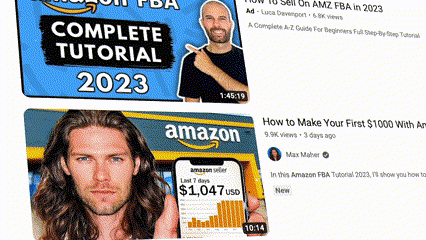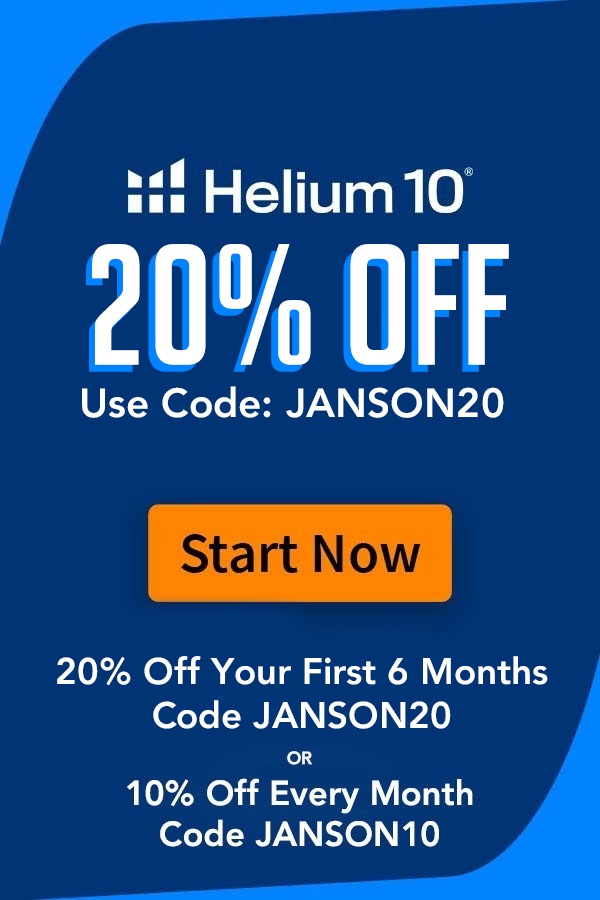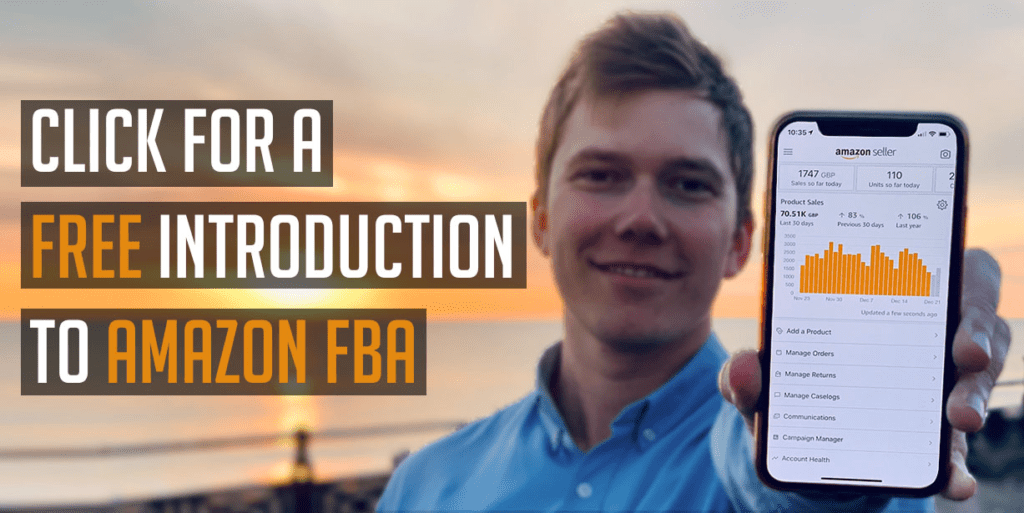
Telling The Truth About Amazon FBA…
As selling on Amazon continues to gain popularity as a great side hustle, each day more and more gurus are popping up YouTube, Facebook Ads, and Tiktok, shouting from the rooftops about what is Amazon FBA, how great it is and how much money it’s possible to make without putting in a jot of effort. All you have to do is spend $997 on one of their courses and they’ll give you the key to unlock the door to financial freedom.

Whilst some of these Amazon FBA gurus are credible and know what they’re talking about, the sad truth is that’s a small minority – the majority of them don’t currently sell on Amazon and in a lot of cases never have become Amazon FBA sellers – which means that the claims that they’re making are just being said to hype you up so that you don’t think twice when they start to pitch you their course.
I’ve been active Amazon FBA seller since 2018, and in that time not only have I built a business that generates 6 figures of profits each year, but I’ve launched enough products and gained enough experience to understand whether an Amazon FBA guru is telling the truth, or feeding their viewers a load of BS, the biggest of which I’ll be exposing today.
LIE 1: You’re Gonna Get Rich… Quickly!
One common mistruth about Amazon FBA is that setting up is an overnight process that will quickly result in you being able to afford Lambos, Rolex watches and business class flights… well that couldn’t be further from the truth. If you’re serious about building a long term, sustainable income stream from selling products on Amazon – you need to understand that it’s going to take time and it’s going to take effort.

Having a successful Amazon FBA business that generates thousands in profits each month isn’t a case of creating an Amazon account and then sending in any old crap that you can find on Alibaba. It requires you to spend time researching many different niches to discover product ideas, analysing data to understand demand and profitability, and just generally spending time finding opportunities that you can turn into a profit. The whole process of finding and launching a successful product on Amazon might take you 6 weeks or it might take you 12. What it most certainly won’t take you is a matter of days, and to be honest, if it did that should concern you – because if it was that easy, then everybody would be doing.
I’ve been selling the same brand of products on Amazon since 2018, and one of the key reasons that I’ve been able to do that, and because when I took the decision that I wanted to have Amazon FBA as a long term side hustle, I shouldn’t provide it with any less care and attention than any other business. When searching for my product, I took my time, I did my research and I ensured that I wasn’t careless when making decisions, and thanks to that strategy, 5 years on I’m still successfully selling the same products. So if you’re going to go down the route of having an Amazon business, follow this approach and ignore any claims from those that say they can get you started in a matter of days or weeks. That way, you’ll remain way more motivated, and it’ll be far more likely that you’ll end up selling a product that generates you an income not for months, but for years.
LIE 2: You Can Get Started With No Money
Fake Amazon FBA gurus love to claim that you can get an Amazon FBA business up and running with stock to sell for as little as $500. Unless you’re in an incredibly fortunate position where you’re able to manufacture your own products very cheaply, getting started with just $500 is a pipedream. Whilst the monthly operating expenses of an Amazon FBA business can be kept relatively low compared to the majority of businesses out there, your main cost – which is going to be the product that you’re selling, is going to require quite a sizeable investment depending on how many units you’re looking to order, and in turn, that is going to be dictated by the level of demand from Amazon customers in your chosen category.

Amazon wants its customers to have the best shopping experience possible, so to facilitate this, it rewards the sellers that manage their product inventory levels well, and it punishes those that constantly run out of stock. So regardless of whether you do manage to find and Amazon FBA supplier that’s happy to sell you $500 worth of units, if it’s not enough to satisfy at least a month’s worth of sales during which you’ll stay in stock, you’ll quickly discover that it’s very hard to hold on to a decent ranking position, which will severely impact the level of profit you can make. So that is why, in my view – it’s just not possible to get started with as little as $500, especially when you factor in costs such as shipping, logo design, products photos and so on.
A far more reasonable amount to start an Amazon FBA business with – in my view – is closer to the £2,000 mark, and even with this you might find that the number of products that you can afford to sell is limited.
With that said, regardless of how much or how little you are planning on starting with, when assessing any product that you’re looking to sell, always check that you can afford at least 4 weeks worth of inventory so that your product’s chances of success aren’t limited by Amazon, for constantly being out of stock.
LIE 3: Successful Amazon FBA Products Need High Revenues And Low Reviews!
Searching for a product to sell on Amazon is going to take time and effort regardless of your level of experience. I’ve got 5 years’ worth of product research practice under my belt, and although I’m considerably quicker at assessing opportunities now than when I first started, it’s still not a quick and easy process if you want to do it properly. And this is an area that involves a lot of fake gurus bending the truth – which is making product research seem incredibly easy when following their methods.
If you search for Amazon product research tutorials on YouTube, it won’t be long before you come across plenty that claim to show a $10,000 product that they found in as little as 60 seconds. Whilst that may be the case – which, with the help of tools such as Helium 10’s Black Box – it’s not difficult to do, to anybody with prior experience will be able to tell you that the products that are identified in these videos are typically those that are either in incredibly saturated niches – such as garlic presses or water bottles, or they’re products that are in niches with low reviews and extremely high sales, which is typically an indicator of a niche that is about to get flooded with competition.
These type of tutorials rarely come with appropriate warnings that the example product being found still needs to be researched further as it may not be a good product to sell. Because of that omission, a lot of beginners will rush through their product research and end up launching a product that’s doomed to fail because they’ve either skipped a key part of the product research process – such as checking profitability or their ability to differentiate – or they’re launching in a niche that’s incredibly saturated.
Product research for successful Amazon FBA sellers takes time and it takes effort – regardless of your experience, your budget, and the latest product research strategy that’s going around on YouTube.
LIE 4: Amazon FBA Is Passive!
When I first discovered Amazon FBA, the most attractive part of it to me, was that it was described as being ‘passive’ once you’d found a product to sell and a supplier to source it from. Although it’s true that the amount of time that you’re required to put into the business significantly reduces once you find and launch your on Amazon, to say that it then becomes a ‘passive’ business is pretty far from the truth.
Every week since I started selling in 2018 has required me to have some sort of input into the running of my Amazon FBA business – whether that be responding to a customer question, ordering more stock with my supplier, tinkering with my advertising campaigns and so on. And whilst I have managed to get the physical amount of time that I spend on my Amazon business down to around 2 hours a week thanks to outsourcing and automations, I still wouldn’t describe it as passive and put it in the same category as something like stock investing for example.
So if you ever see someone say that Amazon FBA is a passive income business model – take it with a pinch of salt. Whilst it’s undoubtedly a business that can be built in your spare time and then managed in a few hours per week, it’s not passive, and if you’re focused on growing it and eventually selling it for a large profit, it’s unlikely it ever will be.
LIE 5: Amazon FBA Is Easy Money!
To be a successful seller on Amazon requires you to be a quick learner and someone able to develop business skills such as data and financial analysis, which you’ll use to do product research, calculate profitability, run and assess advertising campaigns, and so much more, sometimes all simultaneously.
When described like that, selling on Amazon might sound quite hard – and that’s because it is, especially if you’re somebody that can easily feel overwhelmed or if you’re doing it completely alone without the help of somebody else to bounce ideas off or seek guidance from.
The difficulty of selling on Amazon is something that you’ll see a lot of gurus avoid talking about, and that’s typically because they don’t know themselves cos they’ve never experienced being an Amazon seller, or they’ve not sold in years.
Whilst it has got easier and more accessible over time, selling on Amazon is never going to be a walk in the park. Whether that be a product that just doesn’t seem to be exciting customers enough to buy, or an advertising campaign that just won’t perform, there’s always going to a problem that need to be solved, some of which you may find so challenging that it makes you want to give up.

Selling on Amazon isn’t for everybody – it requires hard work, determination, and a lot of stamina – and ultimately, if you’re not somebody that’s motivated a lot by money, then the reality is that you might not think it’s worth the effort and the headaches that it can cause. I have days where I’ve been so frustrated that I’ve really considered throwing in the towel, and that’s after 5 years of building something that I’m incredibly proud of.
But, given my motivations and the fact that I understood that it was never going to be a completely easy ride, I’ve always kept going and so far managed to solve all of the problems that I’ve encountered.
SO my advice here is – if you’re looking to start Amazon FBA, make sure that you’re up for a challenge, and that you’re ready to learn and then implement a tonne of skills that you’ll be developing as you go through the journey. It’s not easy, but if you understand that and set your expectations, you’ll be far more likely to stay motivated and end up at the finish line.
Conclusion
If you’re still ready and raring to go now that you’ve learnt the truth about many parts of Amazon FBA, and you’re looking to be guided through the entire process – apply to become a member of HonestFBA’s training programme where you’ll receive guidance & support from our team of 7-figure Amazon FBA seller experts whenever you need it.
Or if you want to learn how you can create an Amazon FBA business yourself, then check out my free training where I’ll teach you everything you need to launch your first product on Amazon and scale to $5,000+ in monthly profit.





